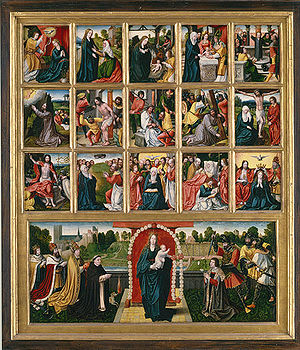
Back Set Goigs de Maria Catalan Sedm radostí Panny Marie Czech Maria Lätitia German Siete gozos de María Spanish Sept joies de la Vierge French Sette gioie della Vergine Italian 성모 칠락 Korean Zeven Vreugden van Maria Dutch Sete alegrias de Maria Portuguese

The Seven Joys of the Virgin (or of Mary, the Mother of Jesus) is a popular devotion to events of the life of the Virgin Mary,[1] arising from a trope of medieval devotional literature and art.
The Seven Joys were frequently depicted in medieval devotional literature and art. The seven joys are usually listed as:
- The Annunciation
- The Nativity of Jesus
- The Adoration of the Magi
- The Resurrection of Christ
- The Ascension of Christ to Heaven
- The Pentecost or Descent of the Holy Spirit upon the Apostles and Mary
- The Coronation of the Virgin in Heaven [1][2]
Alternative choices were made and might include the Visitation and the Finding in the Temple, as in the Seven Joyful Mysteries of the Life of the Ever-Blessed Virgin from St. Vincent's Manual, or the Franciscan Crown form of Rosary, which uses the Seven Joys, but omits the Ascension and Pentecost. Depiction in art of the Assumption of Mary may replace or be combined with the Coronation, especially from the 15th century onwards; by the 17th century it is the norm. As with other sets of scenes, the different practical implications of depictions in different media such as painting, ivory miniature carving, liturgical drama and music led to different conventions by medium, as well as other factors such as geography and the influence of different religious orders. There is a matching set of seven Sorrows of the Virgin; both sets influenced the selection of scenes in depictions of the Life of the Virgin.
| Part of a series on the |
| Mariology of the Catholic Church |
|---|
 |
|
|
Originally, there were five joys of the Virgin.[1] Later, that number increased to seven, nine, and even fifteen in medieval literature,[3] although seven remained the most common number, and others are rarely found in art. The five joys of Mary are mentioned in the 14th-century poem Sir Gawain and the Green Knight as a source of Gawain's strength.[4] The devotion was especially popular in pre-Reformation England. The French writer Antoine de la Sale completed a satire called Les Quinze Joies de mariage ("The Fifteen Joys of Marriage") in about 1462, which partly parodied the form of Les Quinze Joies de Notre Dame ("The Fifteen Joys of Our Lady"), a popular litany.
- ^ a b c Ball, Ann (2003). "Seven Joys of Mary". Encyclopedia of Catholic Devotions and Practices. Huntington IN: Our Sunday Visitor. p. 522. ISBN 0-87973-910-X.
- ^ G Schiller, Iconography of Christian Art, Vol. I,1971 (English trans from German), Lund Humphries, London, p52 , ISBN 0-85331-270-2
- ^ George Coffin Taylor, "Relations of Lyric and Drama in Mediaeval England," Modern -Philology, January 1907, p. 6
- ^ John Anthony Burrow, A Reading of Sir Gawain and the Green Knight, Routledge, 1977, p. 45, ISBN 0-7100-8695-4